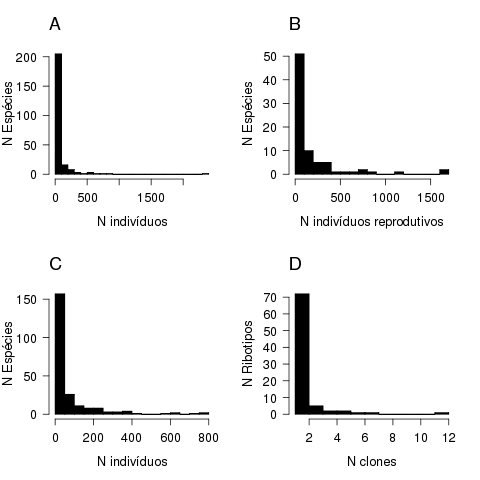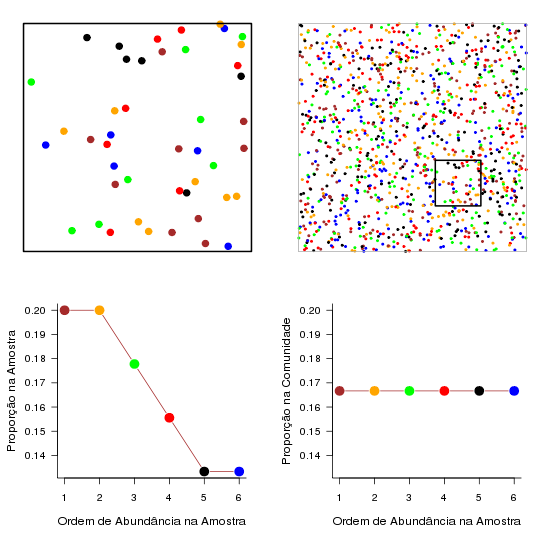Tabela de conteúdos
Research: Modelling SADs
One of the few general laws in ecology is that most species in biological communities are rare.

Species abundance distributions 1) from samples of (A) Moths, (B) Birds, (C) Trees, (D) Microbes. See Prado (2009).
Many models were proposed to describe this pattern, but such a proliferation of explanations for the same pattern is an acknowledged embarrassment for ecologists.
We are working to fill four basic gaps that contribute to this scientific failure:
- Few standardized comparisons of the concurrent models
- Inadequate statistical methods to fit and to compare the models
- Sampling effects not included in some models
- The link between the pattern described by the models and the underlying ecological processes is not always clearly defined and evaluated.
Goals
- To set and test a standarzide protocol to fit and to compare SAD models;
- To evaluate teh effectiveness of this protocol to detect changes in biological diversity along environmental gradinets;
- To simulate different community dynamics and to test the fit of different SAD models.
Maximum Likelihood Fitting
We are working in a protocol of model fitting and comparison based on the maximum likelihood principle 2).
For SADs competing models may be different theoretical probability distributions, or the same distribution with different parameter values. This approach allows assessing whether an environmental gradient affects the type of abundance distribution, or just its shape.
The Sampling Effect
Besides environmental factors, sampling is another source of variation in the observed abundances of species that should be included in models of SADs. We now have a Sampling Theory which formalizes how this can be done. A brief introduction and references are here.

Even if the abundances of species are equal in the community, they will be different in the sample.
Computer Simulations
Simple generating process were deduced for many SAD models. Therefore, it is possible to simulate in computer communities generated by these processes, and verify if in fact they converge to the theoretical SADs.
Also we can simulate samples from these virtual communities to assess the effect of sampling, as shown in the figure above and in this tutorial in R.
R package
An R package to run the statistical protocols described above is in progress. You can check the working version here.
Funding
More Info
- Original research proposal (in portuguese).
- This research include research projects of our students, see our ongoing projects page.
- For a introduction on our likelihood-based approach, please see our course wikisite on statistical modelling (in portuguese)
- A quick introduction to likelihood-based model fitting and comparison is here (in portuguese).
- An R-tutorial on sampling theory of SADs is here (in portuguese).
Basic Reading
<bibtex>
@BOOK{Magurran2004,
title = {Measuring Biological Diversity},
publisher = {Blackwell},
year = {2004},
author = {Magurran, A.E.}
} @INCOLLECTION{May1975,
author = {May, R. M.},
title = {Patterns of Species Abundance and Diversity},
booktitle = {Ecology and Evolution of Communities},
publisher = {Harvard University Press},
year = {1975},
editor = {Cody, Martin L. and Diamond, Jared M. },
chapter = {4},
pages = {81--120},
address = {Cambridge, MA},
}
@ARTICLE{McGill2007,
author = {McGill, B.J. and Etienne, R.S. and Gray, J.S. and Alonso, D. and
Anderson, M.J. and Benecha, H.K. and Dornelas, M. and Enquist, B.J.
and Green, J.L and He, F. and Hurlbert, A.H. and Magurran, A. E.
and Marquet, P.A. and Maurer, B.A. and Ostling, A. and Soykan, C.U.
and Ugland, K.I. and White, E.},
title = {Species abundance distributions: moving beyond single prediction
theories to integration within an ecological framework},
journal = {Ecology Letters},
year = {2007},
volume = {10},
pages = {995-1015},
number = {10},
month = {oct},
owner = {paulo},
timestamp = {2009.04.23}
}
@ARTICLE{Prado2009,
author = {Prado, P I},
title = {Distribuições de Abundâncias de Espécies: avanços analíticos para entender um padrão básico em ecologia},
journal = {Ciência e Ambiente},
year = {2009},
volume = {39},
pages = {121 -- 136},
file={:prado:prado2009_ca.pdf}
}
@BOOK{,
title = {Species Coexistence - Ecological and Evolutionary Perspectives},
publisher = {Blackwell Science},
year = {1999},
author = {Tokeshi, M},
address = {London},
owner = {paulo},
timestamp = {2009.04.14}
} </bibtex>
Error: Undefined constant "AUTH_WRITE"
An unforeseen error has occured. This is most likely a bug somewhere.
More info has been written to the DokuWiki error log.